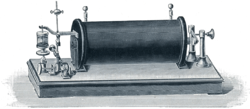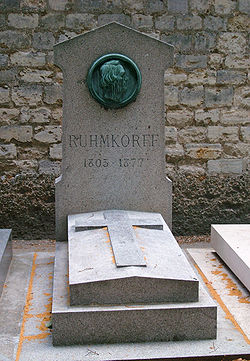
Heinrich Daniel Ruhmkorff
Encyclopedia


Hanover
Hanover or Hannover, on the river Leine, is the capital of the federal state of Lower Saxony , Germany and was once by personal union the family seat of the Hanoverian Kings of Great Britain, under their title as the dukes of Brunswick-Lüneburg...
– December 20, 1877 in Paris
Paris
Paris is the capital and largest city in France, situated on the river Seine, in northern France, at the heart of the Île-de-France region...
) was a German
Germany
Germany , officially the Federal Republic of Germany , is a federal parliamentary republic in Europe. The country consists of 16 states while the capital and largest city is Berlin. Germany covers an area of 357,021 km2 and has a largely temperate seasonal climate...
instrument maker who commercialised the induction coil
Induction coil
An induction coil or "spark coil" is a type of disruptive discharge coil. It is a type of electrical transformer used to produce high-voltage pulses from a low-voltage direct current supply...
(often referred to as the Ruhmkorff coil.)
Ruhmkorff was born in Hanover
Hanover
Hanover or Hannover, on the river Leine, is the capital of the federal state of Lower Saxony , Germany and was once by personal union the family seat of the Hanoverian Kings of Great Britain, under their title as the dukes of Brunswick-Lüneburg...
. He changed the "ü" to "u" in his name when living abroad. After an apprenticeship with a German mechanic, he moved to England. Biographies say that he worked with the inventor Joseph Bramah
Joseph Bramah
Joseph Bramah , born Stainborough Lane Farm, Wentworth, Yorkshire, England, was an inventor and locksmith. He is best known for having invented the hydraulic press...
, but this is unlikely since Bramah died in 1814. He may, though, have worked for the Bramah company
Joseph Bramah
Joseph Bramah , born Stainborough Lane Farm, Wentworth, Yorkshire, England, was an inventor and locksmith. He is best known for having invented the hydraulic press...
. In 1855, he set up a shop in Paris
Paris
Paris is the capital and largest city in France, situated on the river Seine, in northern France, at the heart of the Île-de-France region...
, where he gained a reputation for the high quality of his electrical apparatus.
Although Ruhmkorff is often credited with the invention of the induction coil
Induction coil
An induction coil or "spark coil" is a type of disruptive discharge coil. It is a type of electrical transformer used to produce high-voltage pulses from a low-voltage direct current supply...
, it was in fact invented by Nicholas Callan
Nicholas Callan
Father Nicholas Joseph Callan was an Irish priest and scientist from Darver, Co. Louth, Ireland. He was Professor of Natural Philosophy in Maynooth College near Dublin from 1834, and is best known for his work on the induction coil....
in 1836. Ruhmkorff's first coil, which he patented in 1851, utilized long windings of copper wire to achieve a spark of approximately 2 inches (50 mm) in length. In 1857, after examining a greatly improved version made by an American inventor, Edward Samuel Ritchie
Edward Samuel Ritchie
Edward Samuel Ritchie , an American inventor and physicist, is considered to be the most innovative instrument maker in nineteenth-century America, making important contributions to both science and navigation.-Early life and career:...
, Ruhmkorff improved his design (as did other engineers), using glass insulation and other innovations to allow the production of sparks more than 30 centimetres long. Ruhmkorff patented the first version of his induction coil in 1851, and its success was such that in 1858 he was awarded a 50,000-franc prize by Napoleon III for the most important discovery in the application of electricity. He died in Paris in 1877.
In several of Jules Verne
Jules Verne
Jules Gabriel Verne was a French author who pioneered the science fiction genre. He is best known for his novels Twenty Thousand Leagues Under the Sea , A Journey to the Center of the Earth , and Around the World in Eighty Days...
's science-fiction novels, so-called "Ruhmkorff lamps" are mentioned. These were an early form of portable electric lamp. The lamp consisted of a Geissler tube
Geissler tube
A Geissler tube is an early gas discharge tube used to demonstrate the principles of electrical glow discharge. The tube was invented by the German physicist and glassblower Heinrich Geissler in 1857...
that was excited by a battery-powered Ruhmkorff induction coil. Intended for use by miners, the lamp was actually developed by A. Dumas and Dr. Benoit.
External links
- Biography with photographs accessed April 12, 2006

